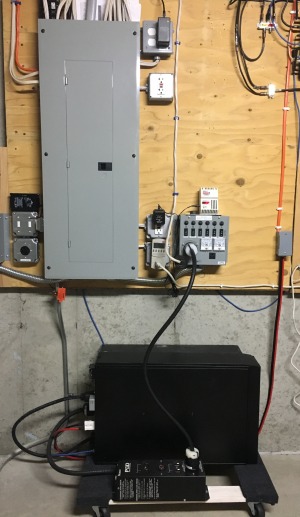

This page provides information on my Prius generator project, which is a system to utilize the battery and charging system of the Toyota Prius to provide power for the home during emergencies.
First off, this isn't my idea, just my particular implementation. Full credit for the idea and research for this project goes to Richard Factor (www.priups.com). Please visit his site if you are interested in all the details.
Disclaimer: This project involves high voltage and other potentially dangerous activities and should not be attempted by anyone unless they know what they are doing!
Note: Brief description of Version 2 is given below (Updated June 2019).
Original Version 1 from 2010 is below


 As can be seen above, the new system is essentially smaller and more compact, despite comprising
two units and supporting the same capacity. The back unit is the SURT003 transformer and the front unit is an
IBM branded version of an APC SURT6000XLI UPS, good for 6000 kVA or 4200 kW. The
UPS only puts out 240V non-center tapped, so the transformer was required to
provide a 120V-CT-120V feed for the transfer switch.
As can be seen above, the new system is essentially smaller and more compact, despite comprising
two units and supporting the same capacity. The back unit is the SURT003 transformer and the front unit is an
IBM branded version of an APC SURT6000XLI UPS, good for 6000 kVA or 4200 kW. The
UPS only puts out 240V non-center tapped, so the transformer was required to
provide a 120V-CT-120V feed for the transfer switch.
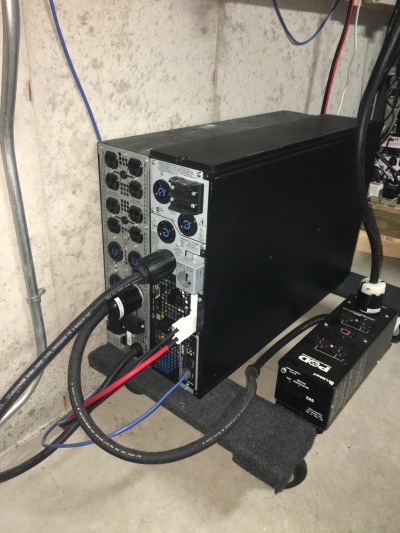 >
>
 The picture above shows the L6-30 connection between the transformer and the UPS.
From the transformer, an L14-30 connection goes to the POD, which was something
I kept from the Liebert, to distribute to two L14-20R and several 120V receptacles.
One L14-20 connector goes to the transfer switch. The Prius battery feed goes into the
external battery pack connector at the back of the UPS.
The picture above shows the L6-30 connection between the transformer and the UPS.
From the transformer, an L14-30 connection goes to the POD, which was something
I kept from the Liebert, to distribute to two L14-20R and several 120V receptacles.
One L14-20 connector goes to the transfer switch. The Prius battery feed goes into the
external battery pack connector at the back of the UPS.
The system works well, and upon power failure, all I have to do is to connect and start up the Prius, power up the UPS and flip the transfer switch. Much simpler than the generator shuffle I used to have to do.
On a side note, just as I implemented this version, the Prius finally gave out the dreaded P0A80 trouble code after 14 years and 155k miles. So I got to change out a bad cell from the HV pack as well. I won't go into it here as it's pretty well documented on numerous Youtube videos. I don't know if it's use as a UPS battery pack affected it's longevity, but you can't really complain after such a long time. After changing one bad cell, it's back to normal and I am getting the usual 2 mins charge, 8 minutes discharge duty cycle that I was getting before.
SPL June 2019
Historical Details (This is Version 1 from April 2010)
Well, in order to get power from the Prius, the first thing that is required is access to the high voltage traction battery. This is achieved by connecting to the high voltage battery leads in the trunk. I did what other people have done, and that is to bring it out to the driver side storage bin in the trunk.
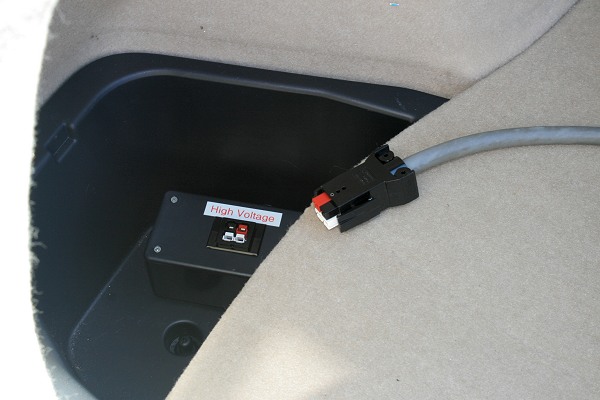
 As you can see above, I brought the battery connections out via Anderson
Powerpole connectors. The corded plug that goes into the socket runs to
another junction box in my garage
As you can see above, I brought the battery connections out via Anderson
Powerpole connectors. The corded plug that goes into the socket runs to
another junction box in my garage
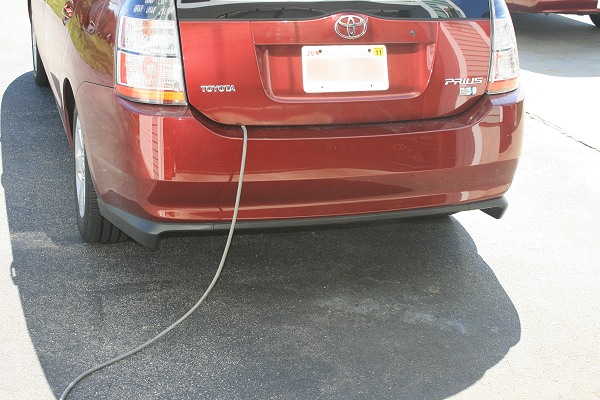
 There's got to be a better way to get the battery cord out of the car!
There's got to be a better way to get the battery cord out of the car!
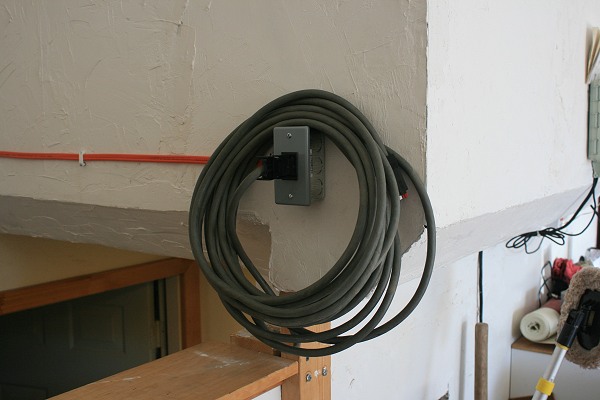
 Here's a view of the battery cord stored on the junction box. The cord is 12
gauge stranded wire, but from the junction box to the UPS, it's 10 gauge Romex.
This runs from the garage to the basement where it connects to the UPS.
Here's a view of the battery cord stored on the junction box. The cord is 12
gauge stranded wire, but from the junction box to the UPS, it's 10 gauge Romex.
This runs from the garage to the basement where it connects to the UPS.
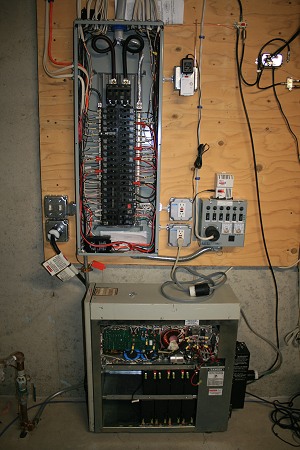
 This is an exposed view of the UPS and load center panel during initial
wiring. The battery wiring from the garage has not yet been run in this
picture. The UPS is a Liebert UPStation S 6KVA unit that I managed to
get on ebay for $295 shipped. The batteries were shot, so I
had to buy new batteries for another $184 shipped, so my total cost for
the UPS was $479. The original batteries were 16 pieces of 12V 12AH
units but I replaced them with 7AH batteries, as runtime wasn't an
issue and they were considerably cheaper. You can see that they occupy
less space than the original batteries in the battery bays.
This is an exposed view of the UPS and load center panel during initial
wiring. The battery wiring from the garage has not yet been run in this
picture. The UPS is a Liebert UPStation S 6KVA unit that I managed to
get on ebay for $295 shipped. The batteries were shot, so I
had to buy new batteries for another $184 shipped, so my total cost for
the UPS was $479. The original batteries were 16 pieces of 12V 12AH
units but I replaced them with 7AH batteries, as runtime wasn't an
issue and they were considerably cheaper. You can see that they occupy
less space than the original batteries in the battery bays.
The UPS consumes about 200W in idle mode, so leaving it on standby continously wasn't an option for me. However, since the unit would not start up without 240V input power, I needed an alternate means of starting it. I settled on using my gas generator to start it. You can see an existing generator transfer switch on the right side of the panel that is normally connected to the generator. When I first loose power, the idea is to first fire up the gas generator until the Prius makes it home, and/or then use the generator to start the UPS. The UPS 240V power outlet on the left of the load center is wired to two cutover switches above it that can switch it from it's normal circuit breaker to the 240V from the generator. Once the UPS is started and connected to the Prius battery, input power can be disconnected and it will now be running on battery. At that point, the input to the transfer switch is switched over to the UPS output (manually via L14R20 plugs), and the gas generator can then be shut down.
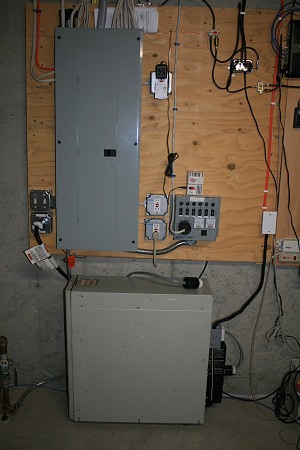
 This is a picture of the completed and closed up system. You can see the
orange Romex carrying the battery connection coming down on the right
side of the picture. The white junction box just provides a way to
switch to flexible wires.
This is a picture of the completed and closed up system. You can see the
orange Romex carrying the battery connection coming down on the right
side of the picture. The white junction box just provides a way to
switch to flexible wires.
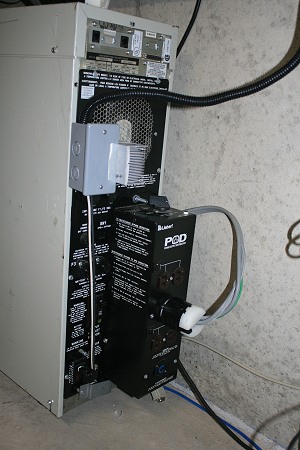
 Here's a close up of the diode and heatsink, which was mounted where the
UPS fan could provide cooling. There is also an inline fuse inside the
junction box. I ran out of 10 gauge cord wire, so I used solid wire from
the box to the extension battery connectors at the bottom.
Here's a close up of the diode and heatsink, which was mounted where the
UPS fan could provide cooling. There is also an inline fuse inside the
junction box. I ran out of 10 gauge cord wire, so I used solid wire from
the box to the extension battery connectors at the bottom.
So, that's it. That's the whole system. It works well. Although I have a 6KVA UPS, my regular loads are less than 3KVA, so it's running very much below it's limits. The battery voltage at the UPS varies between 210V and 245V when connected to the Prius, which equates to 2 and 3 bars respectively on the Prius display. I had some concerns that the high voltage might cause the UPS batteries to overcharge and start to gas, but it is at that high voltage for less than 30 seconds before the engine shuts off and the voltage starts to drop. At my normal consumption, which is mostly computers, furnaces, entertainment system, lights, etc, the Prius runs a 23-33% duty cycle. Charging seems to take about 2 1/2 minutes and discharge times vary from 8 to 5 minutes, depending on the load.
I look forward to the next power outage :)
Constructive comments or questions are welcomed at priusgen (at) sandbox.org
** Update - Nov 2011
On October 29th, 2011, an early winter storm took out power for almost 2 full days.
The Prius generator performed flawlessly, and consumed about 5 gallons per day, which
was a lot less than a normal generator, but still a lot more than the grid.